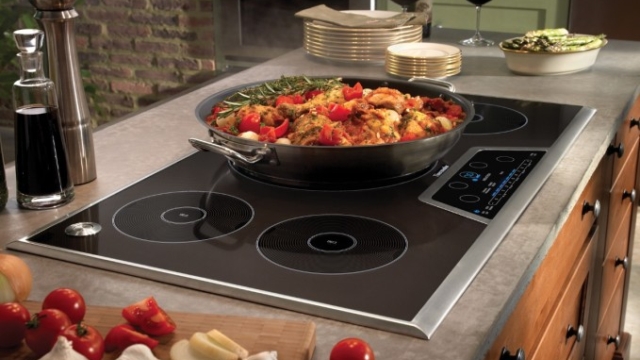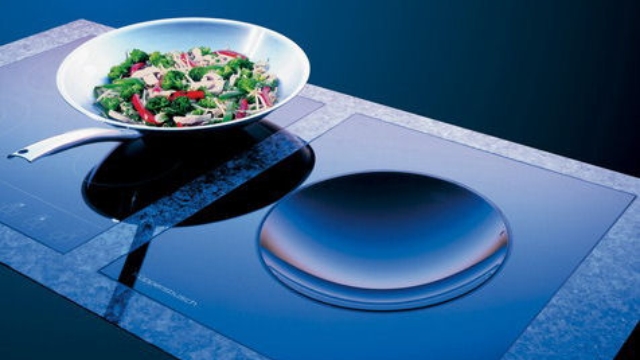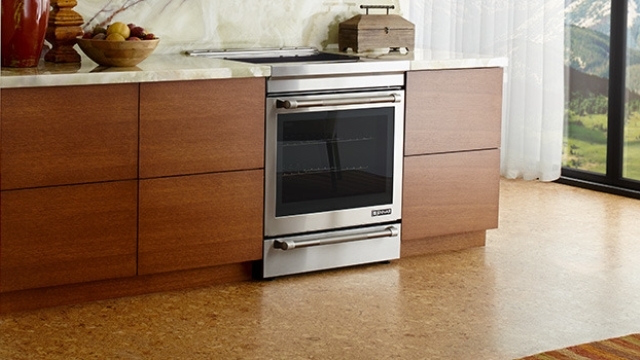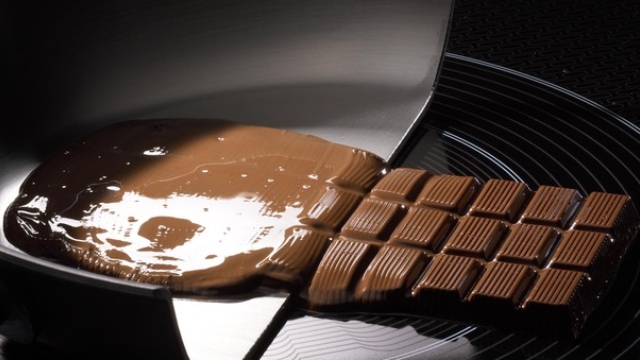The Induction Site
Search this site, or just roll your cursor over the colored boxes below the pictures.Advertisement:
Advertisement:
Advertisement:
Advertisement:




"Give us the tools and we will finish the job."
—Winston Churchill
Quick page jumps:
Induction, as is well known, works only with cookware that is made of a metal containing a suitable proportion of ferrous material (basically iron). Those coming new to induction may find themselves with a deal of cookware that they can no longer use. By and large, replacing such cookware need not be an instantaneous large expense: replacing key items of cookware with cast-iron cookware is relatively inexpensive. But sometimes there will be an item of a special nature or for a special use, perhaps made of ceramic or glass/pyrex, that one wants to still be able to use. (Or an item of ferrous material but too small a diameter—say under 5 inches wide, like a "butter warmer"—to register with most induction-cooktop elements.) Such items can still be used by employing a so-called “induction disk”. (Note that their makers variously spell the word "disc" and "disk".)
An induction disk is exactly what its name says: it is a flat disk that sits on the surface of an induction cooktop and gets heated by the element, just as would, say, the bottom of a skillet. (Indeed, extant induction disks are essentially just skillets with no sides.) The disk thus becomes a hot cooking surface on which a piece of non-ferrous cookware (or under-sized ferrous) can be placed for cooking. Rather obviously, this technique severely wastes many of induction's qualities: it is energy-inefficient, and thus spills much waste heat into the kitchen; it is not instantly responsive; and it is a burn hazard. But if you have those few pieces of special cookware—that glass coffee maker, that charming butter warmer—that you just don’t want to abandon, this is the way to go.
(Nonetheless, you need to be aware that most expert commenters on the matter abominate these things (here's an example). One common suggestion is a small butane-powered countertop heater, of which Iwatani makes a good one. We would never use a disk save for some very small job involving a glass or ceramic item of cookware, and then only reluctantly.)
There are significant differences between brands (besides in price). Some are made of materials such that they cannot (or at least should not) reach temperatures above what on a build-in unit would be considered "middle-level" power; others, built of different materials, can tolerate even the highest powers. Note that the better-made of these things are not really cheap, for the same reasons no good cookware is cheap; beware disks under, say, $20, though for the small jobs that are all you should ever use them for, they may suffice.
(You might find illuminating the disk weights, when they are given, in the Tables below; heavier means more metal and thus more even heating. The Max Burton, for example, is a full 3 pounds, while many others are around 1 pound.)
Also beware handles that are not heat-resistant: you can get a whacking good burn from the hot handle of a poorly made disk.
As examples, Mauviel’s instruction say “Always use the interface disc on a low temperature.” The Max Burton disk does not have such a restriction; you should be aware, though, that many induction units (including Burton's own) will—for safety reasons—power down if the surface temperature exceeds some value, typically about 450° F. (which is awfully hot), so there may be minor use limitations not inherent in the disk itself. (We say “minor” because not a lot of uses need pot-base temperatures of over 450°.) We do not know about the other makers' temparature capabilities, but their literature suggests caution.
(Whether an actual induction-ready skillet could be used as an induction disk is a question we have never put to the test, though logic suggests that it could. But heating cookware “dry” is typically not recommended by cookware makers, which is why we've never gotten round to trying it and don't recommend it.)
The induction disks of which we are aware are shown below, with click-on Amazon links. Cooks Illustrated, a leading reviewer of cooking equipment, much preferred the Max Burton 6010 to the only other two then available (the Mauviel and an Emile Henry, the latter apparently no longer made). These things now come in different diameters; if you’re going to use one, match it to the size of the element on which you intend to use it.
| (Despite the white color, the lines below are all click-on links.) |
| 7¼-Inch-Diameter Induction Disks |
| 7½-Inch-Diameter Induction Disks |
| 7.8-Inch-Diameter Induction Disks |
| 8-Inch-Diameter Induction Disks |
| 9-Inch-Diameter Induction Disks |
| 9¼-Inch-Diameter Induction Disks |
| 9½-Inch-Diameter Induction Disks |
| 11-Inch-Diameter Induction Disks |
|
7¼-Inch-Diameter Induction Disks: |
|||
Artestia 7¼":
|
Sorry, not available Sorry, this item not available through Amazon. |
|
|
Anmas 7¼":
|
Sorry, not available Sorry, this item not available through Amazon. |
|
|
|
7½-Inch-Diameter Induction Disks: |
|||
VonShef 7½":
|
Sorry, not available Sorry, this item not available through Amazon. |
|
|
GAS ONE 7½":
|
Sorry, not available Sorry, this item not available through Amazon. |
|
|
Concord 7½":
|
Sorry, not available Sorry, this item not available through Amazon. |
|
|
Mauviel 7½":
|
Sorry, not available Sorry, this item not available through Amazon. |
|
|
Ballington 7½":
|
Sorry, not available Sorry, this item not available through Amazon. |
|
|
Windmax 7½":
|
Sorry, not available Sorry, this item not available through Amazon. |
|
|
|
7.8-Inch-Diameter Induction Disks: |
|||
Upromax 7.8":
|
Sorry, not available Sorry, this item not available through Amazon. |
|
|
|
8-Inch-Diameter Induction Disks: |
|||
Max Burton 8":
|
Sorry, not available Sorry, this item not available through Amazon. |
|
|
Denmark 8":
|
Sorry, not available Sorry, this item not available through Amazon. |
|
|
|
9-Inch-Diameter Induction Disks: |
|||
Upromax 9":
|
Sorry, not available Sorry, this item not available through Amazon. |
|
|
|
9¼-Inch-Diameter Induction Disks: |
|||
VonShef 9¼":
|
Sorry, not available Sorry, this item not available through Amazon. |
|
|
Think Crucial 9¼":
|
Sorry, not available Sorry, this item not available through Amazon. |
|
|
Windmax 9¼":
|
Sorry, not available Sorry, this item not available through Amazon. |
|
|
Anmas 9¼":
|
Sorry, not available Sorry, this item not available through Amazon. |
|
|
|
9½-Inch-Diameter Induction Disks: |
|||
Concord 9½":
|
Sorry, not available Sorry, this item not available through Amazon. |
|
|
Ballington 9½":
|
Sorry, not available Sorry, this item not available through Amazon. |
|
|
|
11-Inch-Diameter Induction Disks: |
|||
Concord 11":
|
Sorry, not available Sorry, this item not available through Amazon. |
|
|
Ballington 11":
|
Sorry, not available Sorry, this item not available through Amazon. |
|
|
Upromax 11":
|
Sorry, not available Sorry, this item not available through Amazon. |
|
|
First, let's take a moment to review the basics of keeping your cooktop looking clean and shiny. The following advice is direct (not word for word, but close) from Schott, the company that manufactures the Ceran brand ceramic glass used by many induction-cooktop makers.
Crucial! If any sugar, or food containing much sugar—preserves, ketchup, tomato sauce, and the like—or a plastic item, or kitchen foil accidentally melts on the hot surface of your cooktop, remove the molten material immediately using a metal razor scraper (see the product lists below) while the cooking surface is still hot, to avoid the risk of damage to the surface. (For safety, wear an oven/potholder mitt while cleaning the hot cooking surface.) This issue is less crucial for induction cooktops than other smoothtop sorts because the surface isn't anything like as hot; but you absolutely, positively do not want sugary stuff baking onto (or into) the surface, so do be prompt if you have such a spill.
First off, and almost too obvious to mention: clean the cooktop surface regularly—ideally after every use. It's sort of like brushing your teeth: a minor task that, if you make it a routine and habit, you scarcely notice. Also almost too obvious to mention—but we will mention it anyway—do not use abrasive sponges or scouring pads, of any sort, nor corrosive cleaners of any sort (such as oven sprays, cleaners containing chlorine or ammonia, or "stain removers").
Now, here are the simple steps in regular care:
First, remove any burnt-on deposits or spilled food from the surface using a suitable razor scraper (see the product lists below); properly used, it will not damage the decorated cooking surface. Hold the scraper at an angle of about 30° to the cooktop surface. (For safety, wear an oven/potholder type mitt while using the razor scraper, lest it slip.) Here also, with induction "burnt-on" deposits are much less likely, but if you do get any, scrape them off when the cooktop is cool. Some sources say to hold the razor scraper at a 45° angle; 30°, 45°, it probably doesn't make much difference, but the lower 30°- angle may be a little less likely to slip and scratch.
Next, when the cooking surface has cooled down, apply a few dabs—each about the size of a dime—of an approved cleaner (see the product lists below) in each element area and work the cleaning cream over the whole cooktop surface using a damp paper towel, as if you were cleaning a window.
Finally, clean the resulting "haze" of cream off with clear water (that is, with a fresh damp paper towel), then wipe the cooktop surface with a clean, dry paper towel.
In sum: keep a razor scraper and a bottle of cleaner by the cooktop; scrape off the occasional rare burnt-on spill, dab a little cleaner on, wipe it over the surface with a paper towel, wipe off with a damp paper towel, wipe dry, and you're done. Nothing to it. (And the razor scraper can be used on other glass surfaces, too, from windows to shower doors.)
(The folks at EuroKera, another maker of ceramic-glass cooktop surfaces, also had a nice little page [now archived] that illustrates the processes listed above.)
Two final thoughts: one, some recommend that after cleaning, you wipe on, with a paper towel, a light coating of isopropyl alcohol (the sort for general use that comes in bottles at the supermarket) and just let it dry (don't wipe it off), leaving a nice, shiny look to the glass; second, if you somehow do have a major burn-on accident, something like frying on some aluminum foil or plastic, Don't panic!—there are ways to clean even those off with few or, often, no permanent effects. Google Is Your Friend in such cases: just don't rush into frantic action, which might make things worse, before looking it up.
Scanning the internet turns up many recommendations for ceramic-glass cleaner brands, but there are three types that Schott describes as "successfully tested and approved" by them for Ceran; it makes sense to stick to one of those, they being:
The one most often mentioned by info pages and in forums is Cerama Bryte, and it's what we use.
Neither of these low-cost items should be ordered on their own, since they come from Amazon where the minimum for free shipping is $35; wait till you're ordering other things that make (or come close to) that $35 total, then add one or both of these in so you don't pay shipping on them. (Also, it may be that the maker of your cooktop included one or both items with the unit; some do.)
Because so many induction-cooktop owners swear by Cerama Bryte, we just list it as the cleaner we offer (in this case, through Amazon):
Cerama Bryte Ceramic-Glass Cooktop Cleaner (28-ounce size)
This is a simple, common tool—you can buy one in any hardware store—but it is amazing how hard it seems to be (based on reading customer reviews) to find one that doesn't have problems. The commonest problem reported is having the blade retract when any nontrivial amount of force is used; on a cooktop, there probably isn't much call for force, but the same tool should have other household uses (cleaning any glass surface—or even getting stickers off auto windshields), so that's a negative. Some have blades that when "retracted" still leave a small, nasty bit exposed (indeed, some do not even allow retracting the blade, which we think an unacceptable safety risk for ordinary household use). And some are comically expensive for such a simple thing. You should check out your local hardware store to see how you like what they may have in stock, but one tool that seems to get good reviews for cooktop use is (not surprisingly) Cerama Bryte's own:
Cerama Bryte Ceramic-Glass Razor Scraper (plus cleaning pad)
Advertisement:
Advertisement:
All content copyright © 2002 - 2025 by The Owlcroft Company.
This web page is strictly compliant with the W3C (World Wide Web Consortium) Extensible HyperText Markup Language (XHTML) Protocol v1.0 (Transitional) and the W3C Cascading Style Sheets (CSS) Protocol v3 — because we care about interoperability. Click on the logos below to test us!
This page was last modified on Monday, 22 January 2024, at 3:09 am Pacific Time.